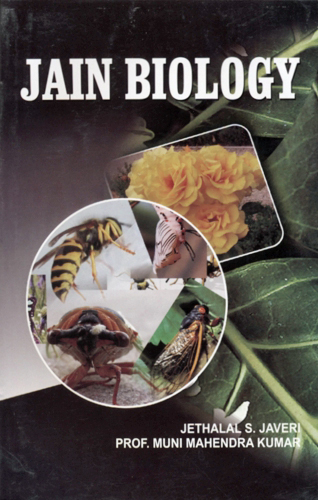Mobile organisms are of three types:
(a) fire-bodied, (b) an bodied.mil (c) organisms with organic-bodied.
It can be seen that (a) and (b) (supra) which are usually classified as sthāvara, and (c) (supra) are regarded as trasa because of their mobility of some kind.
(A) FIRE-BODIED ORGANISMSFire is animate like earth and water. Whenever a fire is lighted living organisms are also produced simultaneously. Only if a fire is extinguished, the fire-bodied organisms die. The gross and fully developed ones are of many kinds; coal fire, chaff fire, fire, flame of lire, meteors, lightning and many more kinds.
The maximum duration of the life of fire-bodied organisms is three days; minimum being less than 48 minutes (antarmuhūrta).
(B) AIR-BODIED ORGANISMSThese organisms are produced in the air whenever a wind of some kind or other is created, naturally or artificially One type of wind kills the organisms produced in another kind of wind. Thus gross and fully developed organisms are of five kinds: gusty wind (squalls), whirlwinds, thick, high and low winds and the saṃvartaka wind, i.e., hurricanes, typhoons etc. thus they are of many varieties.
The maximum duration of the life of air-bodied organisms is three thousands years, minimum being less than 48 minutes.
(C) MOBILE ORGANISMS WITH ORGANIC BODIES
These are of four kinds:
- organisms which possess two sense-organs
- organisms which possess three sense-organs
- organisms which possess four sense-organs
- organisms which possess five sense-organs
- Earthworms and other types of worms, shells, conches, cowries, leeches and many other kinds of organisms with two sense-organs. The maximum duration of the life of these organisms is twelve years, the minimum being less than 48 minutes (antarmuhūrta).
- Kunthu,[1] different kinds of ants and bugs, white ants, centipedes, cochineal and many other kinds of organisms with three sense-organs. The maximum duration of their life is 49 days.
- Different kinds of flies and mosquitoes, bees, moths, scorpions, crickets and many other types of organisms with four sense-organs. The maximum span of life for these organisms is six months.
- Organisms with all the five sense-organs are of four kinds:
- Denizens of hell: They are of seven kinds according to the seven hells called Ratnaprabha, etc. [2] The maximum and minimum duration of the life of the denizens of hell is different
HELL
MINIMUM
MAXIMUM
First
Ten thousand years
1 sāgaropama
Second
1 sāgaropama
3 sāgaropama
Third
3 sāgaropama
7 sāgaropama
Fourth
7 sāgaropama
10 sāgaropama
Fifth
10 sāgaropama
17 sāgaropama
Sixth
17 sāgaropama
22 sāgaropama
Seventh
22 sāgaropama
33 sāgaropama
- The sub-human ¡mimáis which possess five sense-organs: They are of two kinds:
- those which originate by generation acquivoca (sammurcchima)
- those which are born from a womb
Each of these are again of three kinds
(i)-Aquatic;(ii) Terrestrial; (iii)Aerial (Birds)- Aquatic animals are of five kinds:
1. Fishes; 2. Tunics and Tortoises; 3. Crocodiles; 4. Makaras; 5. Gianl whales and porpoises, dolphins etc. - Terrestrial or land animals are of two kinds:
1. Quadrupeds and 2. Reptiles
Quadrupeds [3] are divided into four kinds on the basis of the construction of their feet:- Solidungular - with solid hoof - as horses
- Biungular - with cleft hoof - as cattle
- Mutiungular - as elephants
- Animals having toes with nails - as lions
- Those which walk on their arms - as lizards
- Those which crawl on their breast - as snakes
- Birds and winged animals are divided into four kinds on the basis of the construction of their wings:
- Those with membranous wings - as bats
- Those with feathered wings - as common birds
- Those with wings in the shape of a box.
- Those with wings which remain outspread
-
- Human beings: They are of two kinds:
- humans originating by generatio acquivoca (sammurchima)
- human born from the wombs of their mothers
Those who are born from the womb of their mothers are of three kinds on the basis of their habitat:- Those living in the karmabhumi
- Those living in the akarmabhumi
- Those living in interjacent islands
They have in the same order, fifteen, thirty and fifty-six subdivisions. Men originating by generatio acquivoca are also of as many kinds, Human beings live but only in a very small part of the cosmos.
-
- The gods or the celestial beings: They are the denizens of heavens, which are of four kinds:
- Bhavanapati (Mansion gods)
- Vyantara (Forest gods)
- Jyotiṣka (Luninous gods)
- Vaimānika (Empyrean gods
Then follow the sub-divisions of gods:
- 15 kinds of Bhavanapatis,
- 8 types of Vyantaras,
- 5 kinds ol Jyotiṣka—Suns, moons, planets, stars, constellations.
- Details of many different kinds of Vaimānikas follow; then then maximum and minimum life-spans are given. In the highest Anuttaravimāna, Sarvārthasiddha there is no difference between maximum and minimum. It is always 13 sāgaropamas.
-
The detailed classification ol living beings (no. 1 to no. 19 as given in the tables at the end on page l21-131) given in this scripture [5] is almost the same as that found in the Prajñāpanā Sūtra (quoted above on pp. 57-59 of this book). What is more Important is the description ofeachtypeof living being with reference to twenty-three characteristic features (given on p. 60 of this book).
Let us first discuss about the various types of the twenty-three features and then classify in tabular form at the end.
A very tiny insect with a body which is hardly 0.1 mm in size, but is visible. Kunthus are sometime found in old books. Their colour is exactly the same as that of the paper.
For detailed discussion of infernals (souls), refer to Bhagavaī (Bhāṣya), Vol.-I, Śatak-1, Sūtras 60-73.
 Jethalal S. Zaveri
Jethalal S. Zaveri
 Prof. Muni Mahendra Kumar
Prof. Muni Mahendra Kumar

